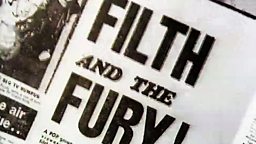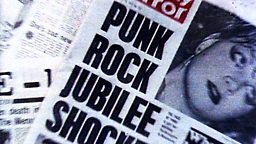The invisible hand of PR: Alan Edwards' 5 tips for pop success
29 January 2016
ALAN EDWARDS has been in the music PR game for over 40 years - in his own words he "was born to do it". Punk opened doors for him early in his career, when he worked with bands like The Stranglers and The Damned from a London squat. Blondie, David Bowie, The Cure, The Rolling Stones, Prince and The Spice Girls would later join the Edwards stable. Edwards presents the final episode of Music Moguls on BBC Four - Myth Makers explains the rise of PR in the music industry. Here, he outlines his 5-point plan for pop success.

PR Alan Edwards, and two members of ‘The Stranglers’ discuss the band’s provocative image
An image that would give the group a reputation for controversy and violence.
1. Get yourself noticed
There are lots of acts being launched at any one time so you’ll have to do something special to get people’s attention - set fire to your guitar; take your clothes off; say something controversial.
Music on its own probably won’t be sufficient.
Try and take a step back and imagine what it’s like to be a tired commuter or busy shop worker and figure out what you’re going to do to capture that person’s imagination.
Image: A Stranglers story from 1978 - Alan Edwards represented key punk bands including The Stranglers, The Buzzcocks and The Damned

2. Have a plan
Think forward to where your artist wants to be in say five years time. Maybe headlining Wembley Stadium or is it being on the front cover of GQ Magazine?
Once you’ve established where you want to get to, then work back month by month and think through all the steps that will be required along the way to get to your desired destination.
Otherwise, it’s like driving up to Glasgow without sat-nav or a map, you’ll probably end up int Bradford or somewhere by mistake!
Image: The Sex Pistols thrived on shock and outrage — and publicity. This story’s prominent play on the front page of The Mirror, following the band's infamous TV interview with Bill Grundy, played directly into that plan.

3. The personal touch always works
Avoid doing things by systems, especially with music.
Nothing beats the experience of playing great new tracks one on one to a journalist. It’s far better than organised playbacks or digital downloads etc.
Also make sure they get to hear it well in advance, that way a busy reviewer working on deadline will have a chance to properly feel the music before they even get down to writing about it.
An example is the Bowie campaign (for Blackstar).
Image: Another Mirror headline, this time following the Pistols' Jubilee boat gig on the Thames.


4. Perseverance and stamina
There will be knock-backs along the way but it’s vital that you keep going.
It’s a bit like knocking on doors, you might find that one in five are answered, but bit by bit you’ll build up a small army of supporters.
You’ll need to dig deep at times and always maintain your belief in the music. Not everybody will get it and that takes stamina both mental and physical.
Always keep the long term objective in mind.
Image: An overblown claim for Suede on the front cover of the Melody Maker.

5. Relationships and honesty
It’s no good cold calling people and expecting them to immediately be interested in your act. It’s all about relationships and like anything worthwhile it’ll take time to build.
Part of that will come about as a result of establishing trust.
It’s a bit like planting seeds, water and nurture them patiently and they may take time to flower, but when they do you’ll have a proper rapport with the media.
Music Moguls | BBC Arts features
-
![]()
Exclusives collection
Exclusive films and features to accompany Music Moguls, the secret story of pop and rock from the greatest producers, managers and PR giants.
-
![]()
Svengalis & thugs
How rock's greatest managers take care of business. Plus extras featuring The Jesus & Mary Chain and The Who.
-
![]()
They're called Hitmakers...
But what the hell do music producers DO? Leading producers reveal all. Includes extras with Tony Visconti and Lee Perry.
-
![]()
5 ways to the top
Alan Edwards, PR guru and presenter of Music Moguls: Myth Makers, delivers his five point plan for pop stardom.
Music Moguls | BBC Four & BBC iPlayer
-
![]()
Money Makers
Part one looks at the maverick managers who controlled the careers of megastar artists. Watch now on BBC iPlayer.
-
![]()
Melody Makers
Part two looks at the producers, from Trevor Horn and Lamont Dozier to Tony Visconti. Watch now on BBC iPlayer.
-
![]()
Myth Makers
Part three looks at PR, the unseen force behind the biggest musical acts in the world. Watch now on BBC iPlayer.
More from BBC Arts
-
![]()
Picasso’s ex-factor
Who are the six women who shaped his life and work?
-
![]()
Quiz: Picasso or pixel?
Can you separate the AI fakes from genuine paintings by Pablo Picasso?
-
![]()
Frida: Fiery, fierce and passionate
The extraordinary life of Mexican artist Frida Kahlo, in her own words
-
![]()
Proms 2023: The best bits
From Yuja Wang to Northern Soul, handpicked stand-out moments from this year's Proms











